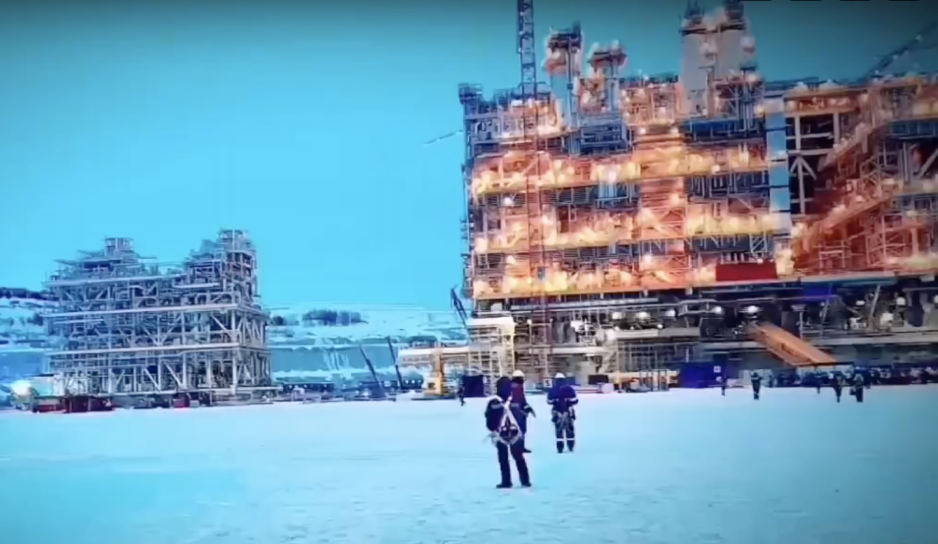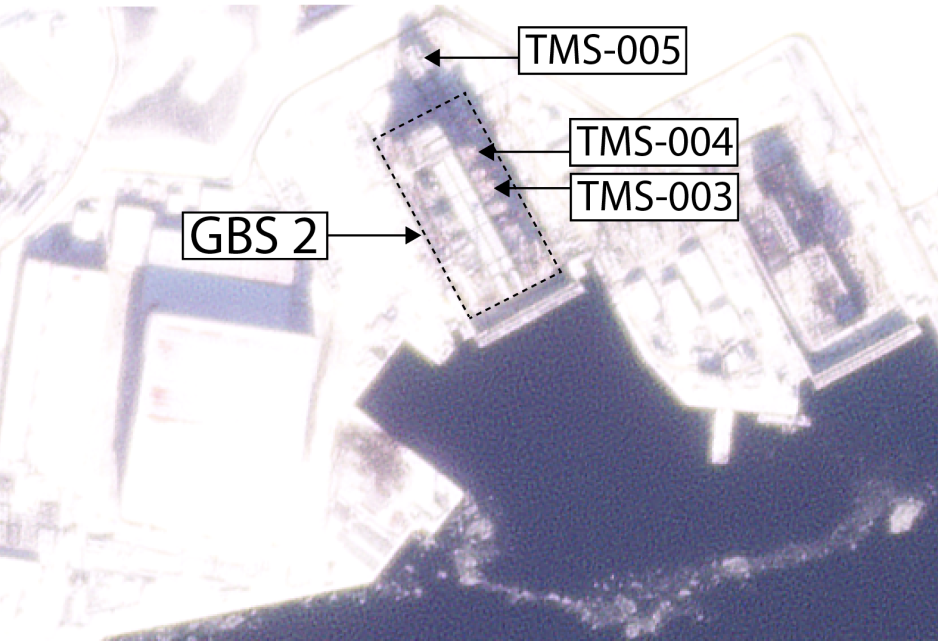Russian LNG 2 Construction Yard Welcomes Final Module and Arrival of Hundreds of Chinese Workers

Image showing GBS 2 on the right with TMS-003/004 on the far left. (Source: Belokamenka VK)
Russian gas producer Novatek continues to assemble the next production line for Arctic LNG 2 all the while it shutters liquefaction of natural gas at the facility due to a lack of ice-capable LNG carriers. The company will look to the summer months, when conventional carriers can reach the project, to initiate shipments. The first conventional LNG carrier received a permit for the Northern Sea Route last week.
Uncertainty over the future of Russian gas producer Novatek’s Arctic LNG 2 project continues to mount. Recent reports suggesting the company ceased liquefaction of natural gas at the facility contrast with a flurry of activity at the Belokamenka construction yard in the Russian Arctic, where Novatek is readying the second production line.
Over the weekend heavy lift vessel Hunter Star delivered the final module for the second train of Arctic LNG 2 after a 2 ½ months journey from China. The transfer of such technology to Russia has been banned under Western sanctions.
Almost simultaneously hundreds of Chinese workers arrived on site, likely to assist with the installation of up to 20 300kW ceramic turbines, CGT30, delivered by Harbin Guanghan Gas Turbine, sources tell HNN. The plant’s second train will employ an all-electric drive using Chinese technology compensating for the lack of American Baker Hughes turbines.
Norwegian stop-overs
Following Hunter Star’s departure from Penglai in northeastern China carrying the 14,000 ton module in early February, the vessel displayed Kirkenes as its destination. This raised concerns that the vessel could plan a stop-over in or near the north Norwegian port to e.g. exchange crew or resupply after the lengthy voyage.
Similar stop-overs to take on provisions and swap crews by LNG carriers carrying Russian gas have occurred in Norway’s territorial waters near Honningsvåg as recently as last year.
The vessel altered the destination displayed via its automatic identification system (AIS) to Murmansk as it rounded the Nordkapp and proceeded to the Belokamenka yard. But not before a Norwegian coast guard vessel KV Jarl, navigating in the waters near Vardø, took a closer look at Hunter Star.

April 2 satellite image showing the final module TMS-005 being maneuvered into position to be added to the GBS platform. (Source: Planet.com)
The dispatching of Chinese workers to help install critical components of the train 2 is likely an attempt to offset the departure of workers from former Western and Japanese project partners. Japan’s Mitsui, part of Arctic LNG 2 through a joint venture with Japan Organization for Metals and Energy Security (JOGMEC), pulled all of its employees out at the end of 2023 ahead of U.S. sanctions targeting the project.
The module delivered by Hunter Star is designated as TMS-005, responsible for power generation. Originally it was supposed to house three LM9000 turbines provided by Baker Hughes to power the entire production line. Following a redesign it will likely house electric components to work in conjunction with the electric motors in neighboring modules TMS-003 and TMS-004.
Following offloading of the module satellite images indicate that it has now been maneuvered into position to be moved onto the gravity-based platform for integration with the other 13 modules that make up the second production line.
Production shuttered for now
For now Novatek appears to have shuttered production of liquefied natural gas (LNG) at Arctic LNG 2 supported by the fact that gas production at the adjacent gas fields has seen a sharp drop from December to February. Declining production figures confirm comments made to HNN about Novatek starting to put some wells into conservation.
However, behind the scenes Novatek appears to put in place the pieces to begin shipments as soon as winter eases its grip on the icy waters on the Kara Sea, likely toward the end of June. Novatek has been unable to procure ice-capable Arc7 carriers and will likely look to use conventional or lower ice-class Arc4 carriers.
The Northern Sea Route administration granted the first permit to a non-ice class LNG carrier last week. Under recently relaxed navigation rules vessels without any ice protection could head for Arctic LNG 2 during a four-month period between July 1 and October 31.



